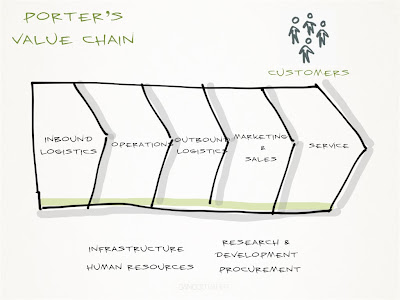I was reading a recent article by Nilofer Merchant on how the Social Era has dramatically altered how we apply these models. Porter's Five Forces describes how a market *should* (or used to) function. What's changed?
- Among competitors, Social has dramatically altered how organizations market, sell and service their products. Done well, it can be a significant competitive advantage. If your company can out hussle on customer service, discounting or promotion using Social channels you can outpace your rivals.
- New Entrants to the market place no longer have to contend with the market power of incumbents. It's much easier to gain a foothold using alternative channels.
- It's the same with Substitutes. (Social) search and sites like Pinterest present the buyer with options they may never have considered and make the transaction costs almost frictionless. Market power and operational efficiency are no longer as important. A nimble company can market, sell and service their product via Social and digital channels. On-demand production trumps large-scale.
- Most significant however is the impact of Social on Buyers. Telling the market, via Social, crowd-sourcing sites (like GroupOn) and shopping comparison tools permit buyers to 'tell' the marketplace what they want and how much they wish to pay.
When I have another look at Porter's Value Chain, there seems to be something missing...THE CUSTOMER. It in fact assumes that the customer is tangential to the process. It assumes a recursive, one to many, broadcast marketing model. This of course is no longer true.
"Every brand already has the ability to get direct feedback from consumers on what they like; the friction cost of doing this is effectively zero through a social media conversation...Social gives companies more control to operationally adjust their offers and create zealots by better collecting and amplifying even weak signals."
Simply, it puts the customer at the centre, not at the end of a chain or process.
What makes this interesting to me are the sociological and cultural underpinnings driving these trends. Faris Yakob first described the concept of 'Diminished Cultural Latency' in 2009.
"There is a correlation between the amount of time it takes to distribute something, and the amount of time it takes for that thing to have an effect, and consequently the amount of time that thing stays relevant and interesting."Or in other words: How long it takes for something to go from a 'Tipping Point' to 'Jumping the Shark'. As these cycles decrease and the frequency with which they increase accelerates, it becomes increasingly difficult to anticipate trends and predict outcomes. Customer and market research - like so many 'How To become a Social Media expert' books -is useless and out of date the moment it's completed.
This diminished latency certainly helps to describe WHY Social has disrupted Porter's (and many other) models. The evidence of the HOW is all around us, but Merchant sums it up nicely:
"The 800-pound gorilla dominated at a time when companies needed and used more capital, when the value chain could be profit maximized through vertical integration. To run this kind of organization, leaders had to be focus on being big enough to enable scale — because that's where the profits once were. Once an organization got big, it took a lot to displace it. But the social era demands something more of our organizations. Something that is qualitatively different. The social era rewards the gazelles — the ones that are fast, fluid, and flexible."



No comments:
Post a Comment